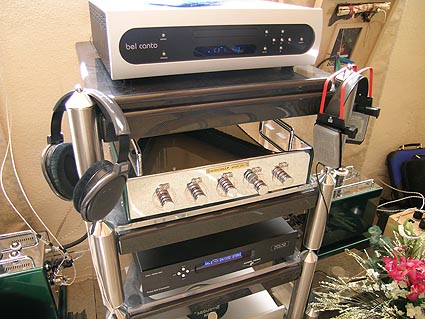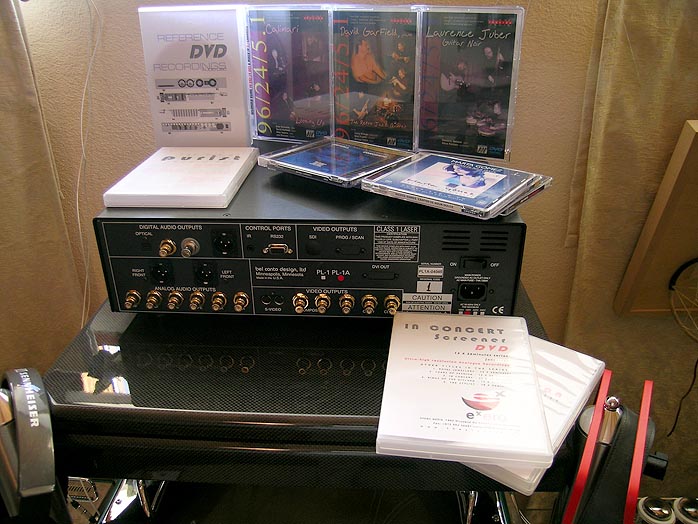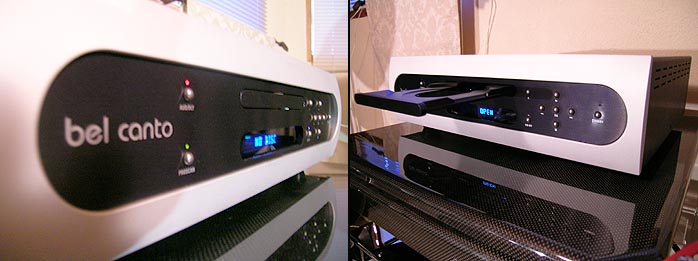|
This review page is supported in part by the sponsor whose ad is displayed above
|
||||||||||
 |
||||||||||
| Based on the significantly higher signal voltage of the PLayer's analog vs. digital outputs (or how the Prima processed either), comparisons required careful level matching. Once the offset had been determined, it took unexpectedly long to come to any conclusions. In the end, the differences were minuscule at best. I was left with two impressions/suspicions. They were repeatable but only on some material. Other CDs diluted these already tiny differences such that I could no longer tell. The S/PDIF feed perhaps was a hair more immediate, direct and articulated, the latter reminiscent of how upgrading from an already good transport to a better one rewards with slightly "faster" leading edges but little else. Mind you, I said perhaps. Definitive hair-splitting territory in other words. I bolted for the figurative door once it became clear that nothing of real note would come out of this approach. Well, let's rephrase this - nothing of audible difference. This in itself was actually very noteworthy. It suggested two things. Since the analog feed placed two output stages in series (the PLayer's and the Prima's), the PLayer's output stage had to be ultra-transparent. No two opinions about that at all. Two, the different conversion strategies arrived at the same place, hence certain spec-driven obsessions about varying chips can perhaps be laid to rest once we're dealing with components of this caliber. On one side, we have the Swiss Anagram sorcery, on the other the contributions of two well-known digital engineers who collaborate with Bel Canto's John Stronczer on certain projects. |
||||||||||
 |
||||||||||
Stage 2 of the tests added the Audiopax preamp into the mix [below]. It connected to both the PLayer and Player-fed Prima SE via identical lengths of ultra-skinny Crystal Cable Reference. Stage three would feed the French DAC from my customary Accustic Arts Drive-1 to add further comparative data. Set to match the PLayer's output voltage via its inbuilt attenuator (its max output is a whopping 5 volts), the Prima could be selected by simply rotating the preamp's input selector without any added level-matching. |
||||||||||
| Setup #2 did make for larger, more easily discernable differences but in the grand scheme of things, they were still small. The Prima DAC added mass, weight and color temperature as though one stepped a bit closer to the acoustic happenings. The PLayer was a shade more distanced, not quite as palpable or oomphy. On highly dynamic material like Dorantes' symphonic Flamenco piano, this added displacement created more impact on peaks when the pianist hammered chordal syncopations in very percussive style. For how I hear and what moves me, nearly all the various facets of these changes could be summed up in the term image density. It's pretty self-explanatory and something I value very highly. |
||||||||||
 |
||||||||||
| Simply put, the whole stereo phenomenon is about ghost images that are created when left and right ear sum their data and, via time arrival differentials, assign localization to specific cues. By definition, a ghost is essentially transparent and immaterial - you can see right through it. The denser and weightier stereo images become, the more we approach a working illusion of physical rather than ghostly performers. This has nothing to do with frequency response or highlighted image outlines but with how fleshy things grow inside those outlines. It's here where the Prima SE went the extra mile - or yard or inch if we were to use more accurate images to better reflect the factual magnitude of this advance. I wasn't surprised that the Prima SE came out ahead. I was surprised by how closely the Player kept up. Going to the Accustic Arts transport via the same Stealth Audio Sextet was probably less than half the previous performance delta, a slight further advantage in transient impact, snap and outline acuity. That was essentially it - a slightly firmer grip and a bit more pop. Now remember that we're dealing with a $5,300 transport, a $5,500 DAC, an extra power cord and a world-class digital interconnect with a final price TBA. If one were exclusively committed to RedBook and had the discretionary income, one might justify these dearly fought-for incremental gains. I have, knowing how the steps become smaller and smaller and disproportionately costlier. On the other hand, solely adding the haunting video image of the PLayer for regular DVD playback into the - er, picture makes a huge argument in its favor. This becomes particularly relevant when you consider that to spread out the mentioned RedBook differences far enough to become audible rather than imaginary means quite the financial investment in a truly top-flight system. Never mind a higher box count and added wiring complexities. Only the most committed audiophiles would feel adequately compensated for parting with the bundle of greenbacks required to play that game. The PLayer's CD performance is simply too close. |
||||||||||
 |
||||||||||
How about SACD? What if you had bought into a sizeable DSD library? I had the CD-only and hybrid SACD versions of Chesky's Cantos de Agua Dulce by Marta Gomez [JD281 and SACD285] on hand to explore what kind of performance delta might separate a superior recording in either format. The first surprise? The SACD was mastered at a considerably lower medium level than the CD. Second surprise? While the spatial aspects of the SACD -- what I think of as "audible space" -- were superior, the firmer incisiveness of the CD versus the less distinct softness of the SACD had me ultimately prefer the CD. I didn't have separate CD covers for Chesky's Remembrances [Jon Faddis, SACD256] and Swing Live [Bucky Pizzarelli, SACD223] SACDs and again noted the far lower than RedBook-usual median recording level. However, the tangible realism of especially the Bucky session was truly awesome. This kind of in-the-booth immediacy is something I only hear on that rare -- often French -- CD from abroad. Perhaps chalk one up for DirectStream though I'm undecided yet on whether I don't honestly prefer superior CDs. However, things hi-rez got really cracking when I finally unwrapped three AIX DVD-As that I had collected a long time ago in anticipation of this review. Besides the live vibe already clearly present on the Chesky SACDs, the soundstage per se grew positively huge now, not by mushrooming instrumental sizes into something grotesque but by sounding big, unfettered, present, potent and uncannily real, with cubits of real air and space. First up was Guitar Noir by Laurence Juber [Aix 80018] followed by David Garfield's Retro Jazz Quintet [Aix 80022] and Calamari's Looking Up [Aix 80023]. Then I progressed to Kostas Metaxas' DVD-Rs sent to me by Kiwi Peter Ball of Kirrabilli Acoustics Ltd in Christchurch. One of these combines 48 tracks from 47 concerts while another is a 60-minutes concert of Sultan Khan playing his sarangi at Panton Hill. The scariest one of the four Metaxas titles I have simply says Andrew Simmons - and its scary because it's so alive. With aliveness comes the willfullness of sentient beings, their unpredictability and the challenge to be present, engaged, on edge and fully interactive. This was full-contact energetic listening in the trenches, not homogenized, sterilized and compressed sleep walking in the aisles. |
||||||||||
 |
||||||||||
Okay, now I was beginning to get some of the hype surrounding hi-rez. Perhaps based on the SACD and DVD-A samples I had and how (or not) they related to my admittedly unusual musical tastes, I got far more excited about DVD-A. Sadly, my favored world-music genre is very poorly covered by either format. Hence I'm very non-committal and generally disinterested about this entire hi-rez affair. To be blunt, it's to the point of not giving a shit. I'm never getting any. However, if you as a listener feel well served by the available music choices in either of the hi-rez catalogues, I will say this: The apparent inherent advantage of these formats (based on my very limited exposure with what presumably are very good examples of the breed) seems to make a musically more relevant forward step than the RedBook-only audiophilish differences in sound I explored just a few moments ago. This seems especially true for DVD-A. Both formats appear to be capable of superior ambient retrieval and a more acute rendering of acoustic space surrounding the performers though SACD also seems slighty less distinct than good old-fashioned RedBook. Let's gather our thoughts to figure out where we're at for the final tally. The PLayer loses merely by a nose and a few hairs against the best dedicated RedBook machines I've had through here. Especially DVD-A is the hammer when someone like AIX's Mark Waldrep lavishes as much attention on the entire process as the XRCD folks from JVC do for CD. And Waldrep adds something into the mix that no CD or SACD would ever dare to dream of: a second video side with session videos, commentary tracks, bios, photo galleries and all manner of "groupie" inside information. Not being well-versed in dedicated DVD-A or SACD players, I cannot comment on how the PLayer compares in those two aspects of its repertoire. But purely based on its phenomenal video image quality and first-rate CD audio performance and my foot-tapping bopping along with Mark Waldrep's DVD-A Jazz jams, it's hard to imagine that the Player isn't at least right up there with other major contenders in the universal genre. Then there's the whole rack of multi-channel concert videos waiting to be ransacked at your local stockist. No matter how I look at the PLayer -- and despite certain pundits going off about the next mo-betta thing around the corner -- today's device is a wickedly accomplished jack-of-all-trades. The PLayer does everything equally well, especially in the two categories I feel qualified to assess: CD playback and picture quality. And yes, it's expensive and thus primarily for those who are secure enough to make a long-term commitment -- a serious purchase -- and won't get bamboozled by the next onslaught of little blue men in rays. If I were John Stronczer at Bel Canto, I might be secretly worried. Is the PLayer too much too late? It sits more or less at the price apex of what its category will bear [though the Linn at $12K is significantly dearer yet]. It sits at the cusp of the next format introduction. ½ of its universal appeal -- SACD and DVD-A -- might be semi-redundant in the eyes of those like me who view both formats as either still-born or prematurely abandoned. |
||||||||||
 |
||||||||||
If those were to be Stronczer's secret worries, I'd counter by saying that RedBook and video DVD are so entrenched and vital a part of Western consumer society that the PLayer's astonishing command of both fully justifies its existence. Never mind the added functionality of SACD, DVD-A and MP3. That's simply a what-if bonus. My only real issue? Many serious 'philes have a dedicated music room and a separate video setup. The latter could be a full-blown extravaganza in a media or living room or a modest little rig like ours. Regardless, that means two locations yet only one PLayer. Hmm. The solution of course is to centralize and streamline. Merge the audio and video systems into one. If that's indeed your blueprint on this matter, the PLayer is a costly but final solution. You might even forgo the surround and center channels and simply focus on assembling a superior two-channel system. The addition of a flat-panel screen wall mounted behind the speakers -- and perhaps fabric-draped when not in use to prevent acoustic reflections -- is all one needs to enjoy a dual-use system that's decor- and user-friendly and ultra performance. It thus would actually get used on a daily basis. (To my mind, home theater with its growing complexities and gimmicky chicanery is nothing more than a marketing-driven ploy to sell you more stuff than you ever needed. Our Gallo Ref3-based 2-channel video system never has us wishing for rear channels. Surround sound simply isn't even on the list of aspirations. It's a complete and utter non-issue. And a center channel? Forget it. The hallmark of a superior stereo system is first-rate center fill.) If a superior all-in-source for audio or audio + video is in your future, you must put the PLayer on your shortlist. It's a jump-off-the-merry-go-round machine for the well-off who approach acquisitions with careful deliberation and devotedly for the long haul but who, with equal deliberation, refuse to spend silly money just because Esoteric's new $13K machine would let you now. My prior familiarity with Bel Canto components allows me to vouch for their reliability. With the updated remote, everything checks out all around for a clean bill of health. Or as our Japanese acupuncturist would say, "you've got the long life pulse of old Japanese men who grow to be above 100". The Player was conceived for this big picture and delivers beautifully. The bit about it being optimized for CD playback is unequivocally factual. That's probably the biggest hurdle a universal player has to clear. After all, those less picky about that buy a DVD player (and what a DVD player this is). So color me deeply impressed with this, my first in-depth encounter with a truly serious multi-format disc player. The only thing lacking? The Player needs a first name. I vote for Major League. |
||||||||||
 |
||||||||||
 |
||||||||||
|
Bel Canto Design website
|
||||||||||
 |
||||||||||